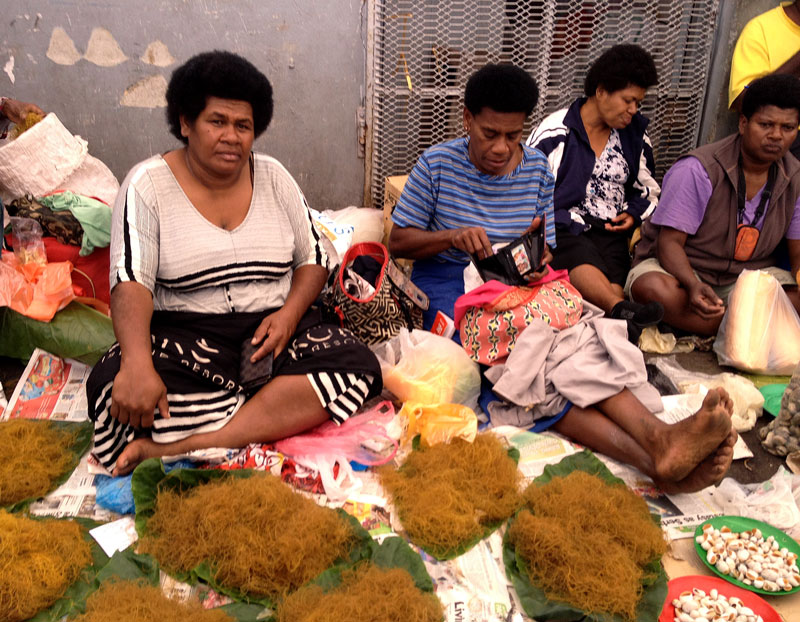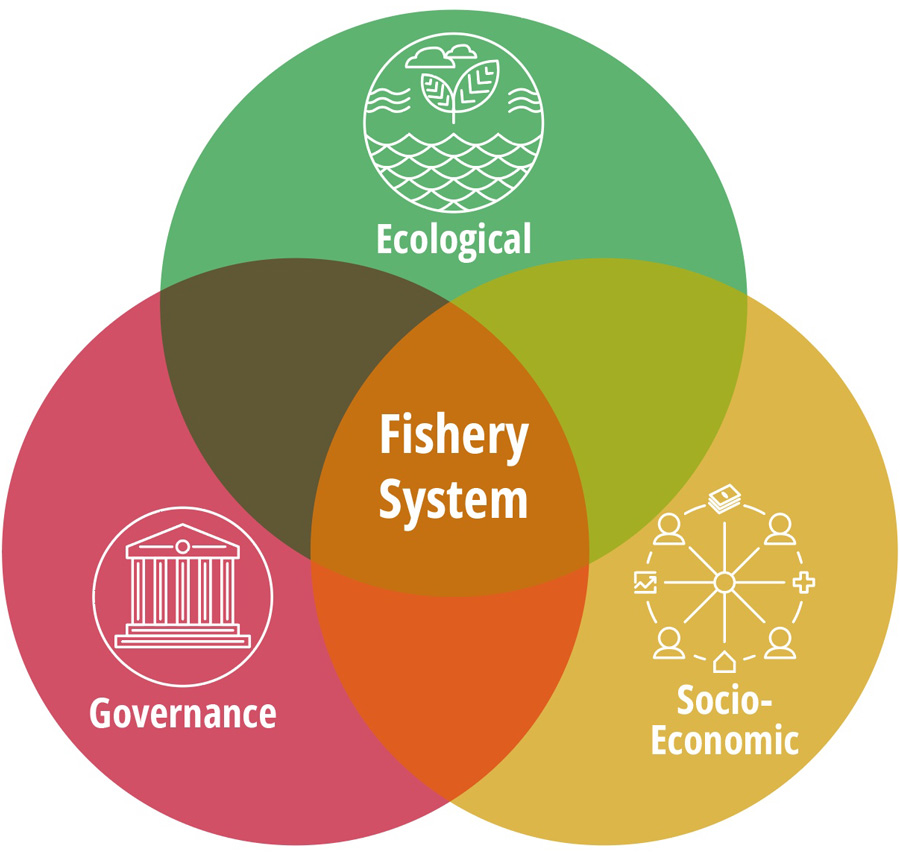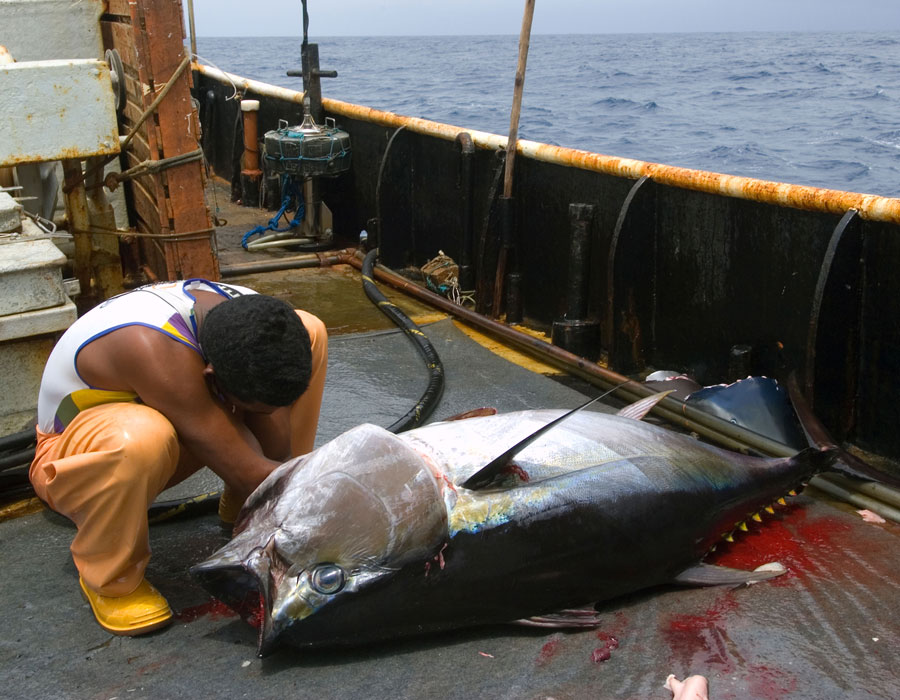STEP 1
Specify the Fishery System
In this step:
- Characterize where, what, and who is in the fishery system for planning purposes
- Identify external factors that influence the system

Women sellers in Suva market. Photo: © Sangeeta Mangubhai
Background
It is important to begin the climate-resilience planning process by defining, as clearly as possible, the fishery system that is under consideration. This step helps facilitate understanding the resource under consideration as well as the main actors who are influencing or affected by the fishery, and therefore who should be involved in the planning process. Understanding these components will influence the scope of climate-related concerns that are considered, the long-term goals that are established, how climate-resilience attributes are assessed, and the actions that are prioritized.
While the assessment and planning process can be approached narrowly or broadly, the system bounds used should be clear, and the planning process should be equitable and inclusive within its bounds by ensuring groups that are part of the system are considered and engaged.
The following questions can be useful to define the fishery system:
- What fish species, vessel types, gear types, fishing ports, types of fishers, and geographic areas will be the focus of planning?
- What are the habitats, oceanographic characteristics, or other ecosystem features associated with the fishery?
- Which political entities, laws, regulations, and monitoring and enforcement systems affect the fishery?
- In addition to fishers, who else has economic, social, or cultural connections to the fishery? For example, what are the businesses and industries in the fishery supply chains? Are there indigenous or local groups that are a part of the fishery or that have strong ties to the resource?
- Are there elders, scientists, or other individuals who hold unique knowledge about the fishery that may be valuable for planning?
When developing the case studies on which the Tool is based, authors used an extensive list of questions that shaped how they defined and bounded each fishery case.

Dimensions of Fishery Systems
Ecological, socio-economic, and governance dimensions of fishery systems contribute to their climate resilience.
For the Climate-Resilient Fisheries Planning Tool, fisheries may be defined in different ways depending on the interests and capacity of those involved in the planning process. We suggest considering the ecological, socio-economic, and governance dimensions of the fishery system, but users can create additional or different categories as needed.
An effective process does not need to include all parts of the broader fishery-related system. Most of the case studies focus on one or a few parts. For example, a fishery may be defined narrowly by including only a single fish species and fishing vessel owners and crew from a single port. Or it may be defined more broadly by including multiple species, multiple ports, the ecosystem that supports the fish species, or additional stakeholders such as supply chain actors, including buyers, processors, marketers, and other non-fishers who rely on the fishery for food and income. Defining the fishery as inclusively as possible given knowledge of the system and capacity for stakeholder engagement will reduce the possibility of the planning goals and actions having unintended consequences for stakeholders.
There are many ways to compile and present the information about the fishery system that is generated in Step 1, ranging from a simple list to a rough sketch diagram to a complex visualization. The choice of how to display the information depends on the intended audience and the skills and time available for completing this step.
Example: Simple System List
ECOLOGICAL
- Fisheries Resources
Examples: Target stocks, predators/prey, bycatch, choke species, protected species, illegal, unreported, or unregulated (IUU) fishing - Habitats
Examples: Nursery areas, spawning areas
SOCIO-ECONOMIC
- Fishers
Examples: Behavioral/cultural groups (e.g., small-scale, industrial, subsistence, recreational), fishing organizations - Supply Chain
Examples: Inspectors, buyers, processors, marketers, importers/exporters, wholesale, retailers, consumers - Other Industries
Examples: Tourism, coastal development, aquaculture, offshore energy production, shipping - Other Stakeholders
Examples: Educators, development groups, dependent stakeholders
GOVERNANCE
- Legislation and Regulation
Examples: Laws and policies, management bodies and institutions at different scales, monitoring and enforcement
FINANCE
- Financial Institutions and Representatives
Examples: Lenders, investors, insurance representatives
SCIENCE
- Research and Analysis
Examples: Fisheries data collection, stock assessments, ecosystem research, social science, fisheries technology, economists
EXTERNAL STRESSORS
- Climate Threats
Examples: Marine heatwaves, increased storm intensity, sea level rise - Non-Climate Threats
Examples: Overfishing, global pandemic
Example: Generic System Map
This figure shows a generic example of a fishery system illustrated in a simple diagram.

Longline fishing for yellowfin tuna. Credit: Animal Stock/Alamy
Case Study Example
U.S. Atlantic/Gulf of Mexico Highly Migratory Pelagic Longline Fishery
The U.S. Atlantic/Gulf of Mexico pelagic longline large-scale fishery is a complex system with a variety of vessels that is subject to national and international management. The U.S.-flagged fleet operates from ports stretching from New England, south along the Atlantic seaboard, into the Caribbean Sea and the Gulf of Mexico, in the U.S. economic exclusive zone and beyond. The Gulf of Mexico fleet is composed almost entirely of Vietnamese-American fishers, most of whom are first-generation immigrants, and many of whom speak limited English. This is contrasted with the Atlantic fleet, where most of the captains and owners are white, native English speakers. Fishery stakeholders include fishers, seafood dealers, scientists, resource managers, and nonprofit conservation organizations.
Climate change is causing target stocks (swordfish and tunas) to shift poleward as waters warm. For some bycatch species like coastal and pelagic sharks, climate impacts will present an additional stressor to populations already affected by overfishing. Climate change is likely to make survival more difficult for many large pelagic sharks, even after they are released alive from fishing gear. The fishery is managed through a governance system that includes U.S. domestic regulators and international regulators from the International Commission for the Conservation of Atlantic Tunas, an international Regional Fishery Management Organization.
Resilience planning efforts for this fishery need to consider the large geographic scale over which the fishery operates to determine if the planning process would be conducted at the full scale of the fishery or for a geographic sub-area. Defining the system also entails determining how the many diverse groups that participate in and manage the fishery will be considered in the assessment and planning effort, being attentive to bringing diverse perspectives into the process.
External Links to Related Tools
Fishery Systems Mapping Tool (EDF): An Excel-based tool to guide users through a thorough system mapping process
Kumu: Visualization software that can help users develop their own customizable system maps
Tasks for Workbook
In the downloadable CRF Planning Tool workbook, complete these tasks on the Step 1 worksheet.
- List elements of the fishery system
- Identify elements determined to be outside the boundaries of the system for planning purposes
- Organize the system
- Group similar elements
- Describe how groups/elements relate
- List stressors that affect the fishery system
CRF Planning Tool Steps